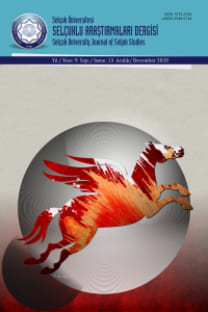TARİH ÖNCESİNDEN BİZANS DÖNEMİNE KADAR KONYA ULAŞIMI VE BALKAYALAR-BAĞIRSIKDERE KALESİ
Bağırsakdere Kalesi, Konya, Miryokefalon, Balkayalar
ROADS IN KONYA FROM PREHISTORIC AGE TO BYZANTINE PERIOD AND BALKAYALAR-BAGIRSIKDERE FORTRESS
Bağırsakdere Fortress, Konya, Myriokephalon, Balkayalar,
___
- Alçiçek, M.C. ve diğ., Homo erectus paleoenvironments in the early Pleistocene Denizli Basin, SW Anatolia, Conference: Colloque Q10. AFEQ CNFINQUA Paléoclimats et environnements quaternaires, quoi de neuf sous le soleil?, At Bordeaux. 2016. İnternet kaynağı: https://www.researchgate.net/profile/Ahmet_Aytek/publication/317342280_Homo_erectus_Subsistence_in_Anatolia_Fossils_and_Tools/links/59347dee0f7e9beee7ccc56d/Homo-erectus-Subsistence-in-Anatolia-Fossils-and-Tools.pdf erişim tarihi: 18.10.2017
- Alp, Gürbüz, “Frigler”, Konya, Haz.Feyzi Halıcı, 41-44/XXXIV-XXXII.
- Bahar, Hasan, “Konya ve Çevresi Tarih Araştırmaları”, Selçuk Üniversitesi Fen-Edebiyat Fakültesi Edebiyat Dergisi, 1994-1995,9-10.s.219-246.
- Bahar, Hasan, ”Tarhuntaşşa Araştırmaları 1994-2002,” V. Uluslararası Hititoloji Kongresi Bildirileri, Çorum 02-08 Eylül 2002, Acts of Vth International Congress of Hittitology, Ankara 2005, s.83-118.
- Bahar, Hasan, Demir Çağında Konya ve Çevresi, Sel-Ün Vakfı Yayınları, Konya 1999.
- Bahar, Hasan, Konya’nın Kırk Höyüğü, Konya Büyükşehir Belediyesi, Konya 2015.
- Bahar, Hasan ve Özdemir Koçak, “Western Links of the Lykaonia plain in the Chacolithic and Early Bronze Age”, XI. Institut Français D’etodes Anatoliennes-Georges Dumezil, De Boccard,Paris 2003, s.21-52.
- Bahar, Hasan ve Özdemir Koçak, Eskiçağ Konya Araştırmaları 2, Neolitik Çağdan Roma Dönemi Sonuna Kadar, Kömen, Konya. 2004,.
- Eskikurt, Adnan, “Myriokephalon Savaşı’na Dair Kronikler ve Modern Çalışmalar”, Chronicles and Modern Reseaches Related with Myriokephalon Battle”, USAD, Bahar 2017; (6): 65-94.
- French, David, “Pre- and Early-Roman Roads of Asia Minor. The Persian Royal Road Author(s)” Iran, British Institute of Persian Studies, 36,1998, s.15-43,
- Haldon, Jhon F., Warfare, State and Society in the Byzantine World, Psychology Press, 1999.
- Hendy, Michael F., Studies in the Byzantine Monetary Economy, c.300-1450.
- Khoniates, Niketas, Historia,Ioannes ve Manuel Komnenos Devirleri, (Çev.. Fikret Işıltan, Türk Tarik Kurumu. Ankara 1995.
- Ramsay, W. M. Ramsay,Notes and Inscriptions from Asia Minor (III), The American Journal of Archaeology and of the History of the Fine Arts, Archaeological Institute of America 2, 2 (Apr. - Jun., 1886), s. 123-131;
- Süryanî Mihael, The Chronicle of Michael the Great, Patriarch of the Syrians (trc. Robert Bedrosian), Sources of the Armenian Tradition, Long Branch, N. J., 2013.
- ISSN: 1015-2105
- Yayın Aralığı: Yılda 2 Sayı
- Başlangıç: 1986
- Yayıncı: Selçuk Üniversitesi
ORTAÇAĞ KRONİKLERİNE GÖRE 17 EYLÜL 1176 MYRİOKEPHALON ZAFERİ (BAĞIRSAK BOĞAZI – KONYA)
BAĞIRSAK BOĞAZI (KONYA) VE YAKIN ÇEVRESİNDE BEŞERİ COĞRAFYA ARAŞTIRMALARI
II. KILIÇARSLAN’IN BİZANS POLİTİKASI
BAĞIRSAK BOĞAZI VE ÇEVRESİNİN (KONYA) FİZİKİ COĞRAFYA ÖZELLİKLERİ
MYRİOKEPHALON SAVAŞI’NIN KONYA BAĞIRSAK BOĞAZI’NA LOKALİZE EDİLMESİNE MİKROTOPONİMİK KATKILAR
MYRİOKEPHALON SAVAŞI (17 EYLÜL 1176) AÇISINDAN KONYA BAĞIRSAK BOĞAZI’NIN COĞRAFİ ÖZELLİKLERİ
KOMNENOS HANEDANI'NIN DOĞU SİYASETİ VE MYRİOKEPHALON SAVAŞI
MYRİOKEPHALON MUHAREBESİ’NİN MEVKİSİ ÜZERİNE
MYRİOKEPHALON ZAFERİ ÖNCESİNDE KONYA’YI HEDEF ALAN ASKERÎ SEFERLER VE YOLLARI
